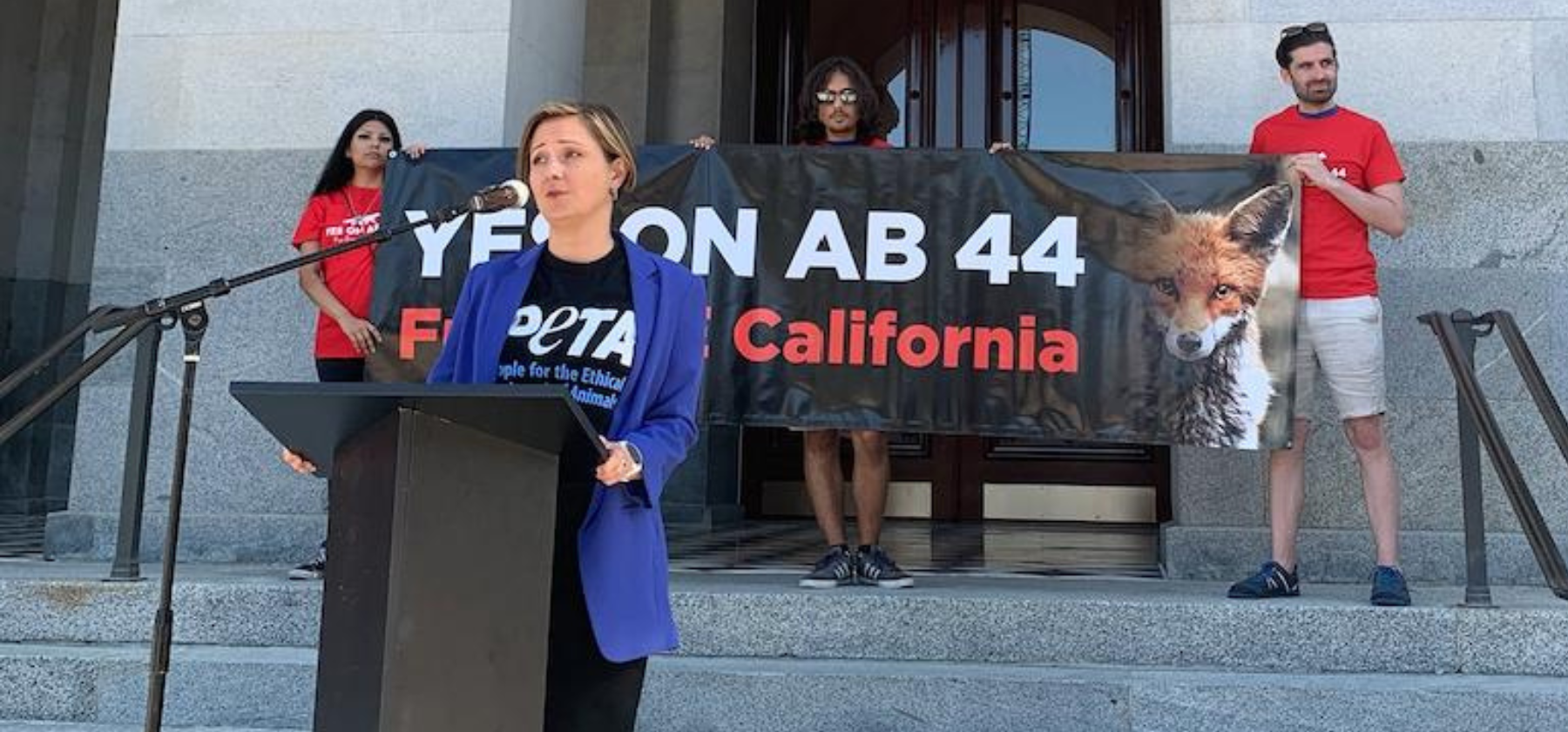When West Hollywood banned fur sales in 2011, the fur industry dismissed it as fringe activism in a famously progressive city. They couldn’t have been more wrong.
As of February 2025, 16 cities across the nation and the entire state of California have gone fur-free, proving that what the industry calls “radical” today can become mainstream policy tomorrow.
Behind each of these headlines lies an inspiring story of grassroots political activism, innovative tactics, and the power of local democracy to create lasting change – along with some crucial lessons for anyone who wants to join the movement to enact fur bans in their community.
Blueprint for Victory: 8 Things Activists Can Learn From Past Legislation
- Know Your Local Democracy: Different approaches work in different places – lobbying city council, ballot initiatives, or town hall meetings. Try to identify if there’s a pro-animal member of your local city council who might be willing to introduce a fur ban.
- Follow the Money: The fur industry’s playbook relies heavily on deception and manufactured opposition. From paying fake protesters and lobbying firms to hiring voters to flood legislators with calls, they’ll spend whatever it takes to create the illusion of public support. Document everything – exposing these tactics is often our most powerful weapon.
- Build Strong Coalitions: While national organizations provide crucial resources and expertise, local grassroots energy wins campaigns. The most successful campaigns combined support and guidance from large established nonprofits with passionate local activism.
- Strategic Timing Matters: When the industry finds out about proposed fur ban legislation early, passing a fur ban can be far more difficult. The fur industry will try to make even the smallest ban seem like economic apocalypse. Avoid drawing too much attention to your initiative while campaigning if at all possible.
- Start Small and Scale Up: The movement’s biggest victories started in cities with minimal fur sales. This isn’t just about picking easy targets – it’s about building precedent while the stakes are lower. Every small-town victory is setting the stage for a future ban at the statewide level.
- Passing Laws Isn’t Enough: Let’s be brutally honest – governments often lack the resources, expertise, or will to enforce animal protection laws. We must be prepared to monitor, document, and pressure for enforcement long after the initial victory. The movement’s future depends not just on passing new laws, but on making existing ones actually work for animals.
- Cultural Sensitivity Is Not Optional: The fur industry has developed a sophisticated playbook for weaponizing cultural and racial issues to derail bans. In 2019, a fur sales ban was on track to pass in New York City, until mobilized opposition successfully framed fur as intrinsic to Black culture and church traditions (offering $250 gift cards to members of a black church for attending a hearing). Last year in Denver, Pro-Animal Future’s fur ban came under fire for harming Native Americans, despite including an exemption for fur intended for traditional tribal, cultural, or spiritual purposes by a member of a Native American tribe (the same exemption nearly every US fur sales ban has included). We learned firsthand about how the opposition will spread misinformation in an attempt to confuse voters or decision-makers. This means prioritizing intersectionality and coalition-building with diverse community groups from the beginning, not as an afterthought.
- You Don’t Need to Be an Expert: From eighth-graders to college students to working-class citizens, many successful campaigns were led by people who were brand new to politics. Organizations like PETA, the Humane Society of the United States, or Animal Legal Defense Fund have the expertise to guide local activists through the process. Passion and persistence matter more than political experience.
The Ultimate Guide to Every US Fur Ban [2025]
West Hollywood, California (2011) – The Pioneer
How did West Hollywood manage to pass the first-ever fur sales ban in the U.S.? Local activists formed “Fur Free WeHo,” working closely with city council candidate John D’Amico to make a compelling case for moving away from fur. The councilors were bombarded with calls, letters, and e-mails from PETA supporters, both local and outside the city.
Despite the Fur Information Council of America’s economic impact study claimed the ban would devastate local businesses and drive retailers out of the city, the city council unanimously voted to ban new fur sales, making West Hollywood the first city in the U.S. to do so. The best part is that when the dust settled, not a single business relocated – a powerful rebuttal that future campaigns would cite again and again.
But the fur industry wasn’t about to lose without a fight. Mayfair House, a specialty clothing store, fought tooth and nail to overturn the ban through lawsuits – twice. Both times, federal judges dismissed the cases as meritless.
However, these legal challenges led to a modification in 2015: the ban was redrafted to allow the sale of fur obtained by lawful trapping, ensuring alignment with California’s Fish and Game code.
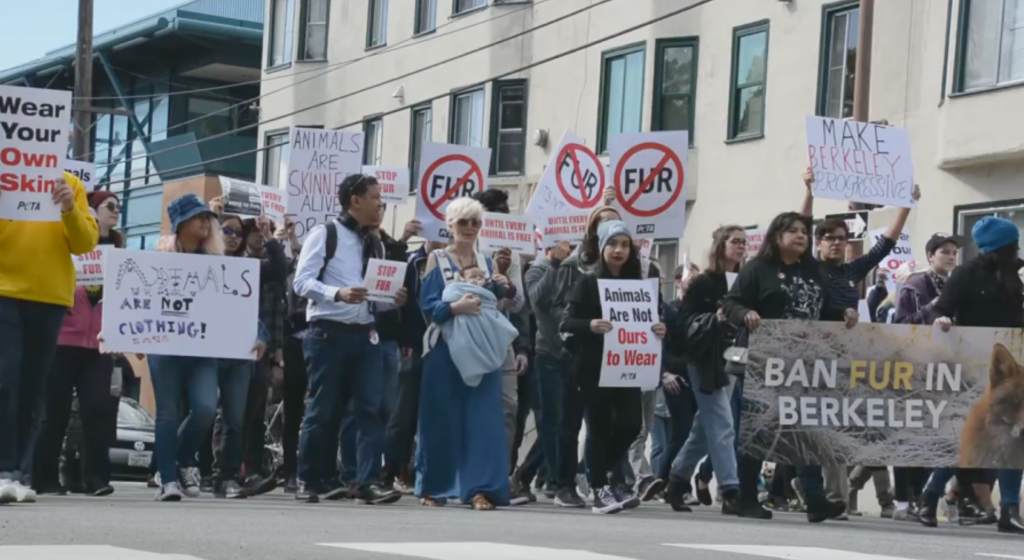
Berkeley, California (2017) – The Midnight Victory
During a dramatic late-night council meeting, advocates from the Berkeley Coalition for Animals stayed until after 11 PM to defend their proposal to ban fur sales. In a significant departure from West Hollywood’s ban 6 years earlier, Councilwoman Sophie Hahn introduced a substitute motion to allow exceptions for selling cowhide and sheepskin, arguing that these animals are already slaughtered for meat.
An activist from DxE noted in an interview on Counterpunch that Hahn spoke about her nostalgic attachment to some sheepskin childhood blanket, a sentiment that the council-member next to her apparently shared (even though the ban only covered apparel).
While several council-members pushed for a complete ban, the compromise version passed 6-3. This new exception would influence subsequent legislation across California.
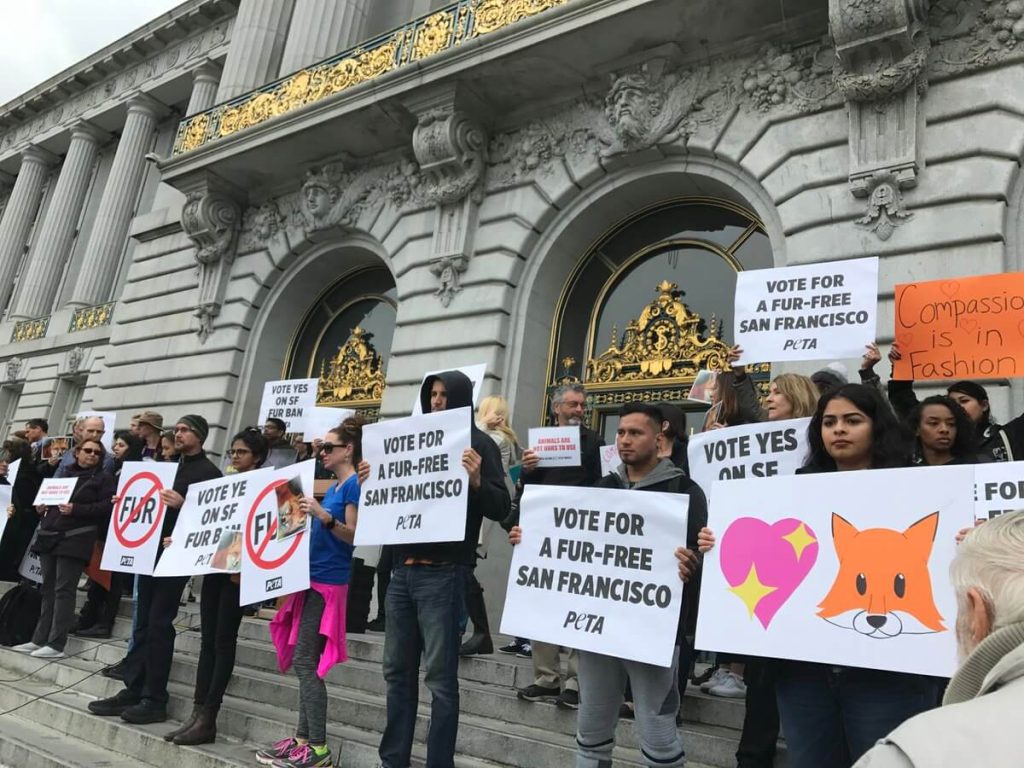
San Francisco, California (2018) – Taking on Big Retail
San Francisco’s ban marked a major escalation – the largest U.S. city to go fur-free at the time. Inspired by the successful bans in West Hollywood and Berkeley, activists from Direct Action Everywhere (DxE) and PETA led aggressive lobbying campaigns, organized protests, and provided investigative reports on animal cruelty in the fur industry.
Supervisor Katy Tang spearheaded the legislation, which was unanimously approved by the Board of Supervisors on March 20, 2018. Following Berkeley’s lead, the ordinance maintained the sheepskin and cowhide exemptions, and like West Hollywood’s revised ban, included provisions for lawfully trapped fur to ensure compatibility with state law.
When the International Fur Trade Federation sued to overturn the ban as unconstitutional, the courts stood firm, ruling that the policy was enforceable against local and online retailers with a physical location within city limits, establishing crucial legal precedent for future bans.
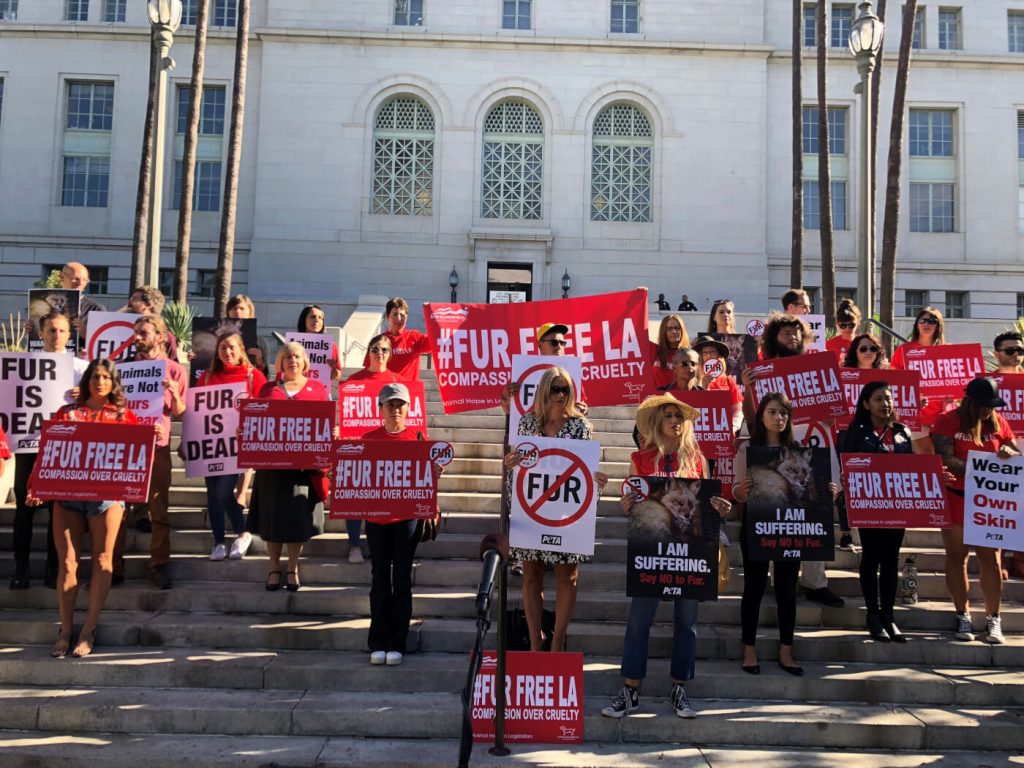
Los Angeles, California (2018) – Building Momentum
Los Angeles demonstrated the power of coalition-building, with In Defense of Animals, Animal Hope in Legislation, and PETA coordinating their efforts. Councilmembers Bob Blumenfield and Paul Koretz championed the cause, leading to a unanimous yes vote.
The ordinance included a two-year phase-out period to reduce impact on furriers and included the first time a US fur sales ban contained exemptions for both Native American cultural uses and religious purposes of any faith.
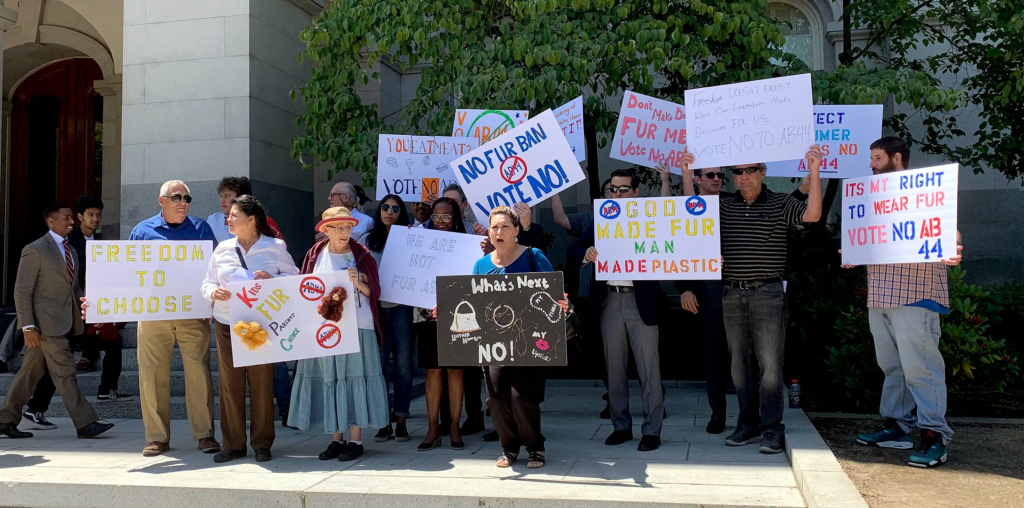
Protesters hired by the fur industry gathered outside the California State Capitol Building to rally against AB 44 after a Senate Judiciary Committee hearing on the bill.
California State (2019) – Making History
California’s passage of Assembly Bill 44 marked a watershed moment – the first statewide fur ban in America. The victory represented years of coordinated activism from PETA, the Humane Society of the United States (HSUS), and Direct Action Everywhere (DxE). Governor Gavin Newsom’s signing of the bill sent a powerful message that would reverberate across the country.
The campaign revealed both the movement’s growing sophistication and the fur industry’s desperate – and deceptive – tactics. Activists uncovered a coordinated astroturfing campaign where the industry paid people $175 to pose as concerned citizens at protests, distribute literature, and flood legislators’ offices with calls opposing the ban.
Their attempts to manufacture fake grassroots opposition reached a new low when they tried to bribe a high school student to oppose the bill. Instead of taking the money, the student went public, exposing how the industry was trying to buy the appearance of youth opposition.
Perhaps most cynically, the industry attempted to reframe the debate around identity politics, paying consultants to argue that fur bans discriminated against African American and other minority communities. Critics pointed out uneven impacts – religious articles worn by Native Americans and Ashkenazi Jews were exempted, while fox stoles popular at black churches and Persian synagogues were not. This strategy aimed to pressure legislators by threatening their relationships with minority constituents.
The work continued after the bill became law. In 2023, HSUS and DxE conducted a major compliance investigation, visiting 24 known fur retailers across the state. Their findings – seven stores still selling illegal fur – highlighted a crucial reality for animal activists: passing legislation is only the first step. Government agencies often lack the resources or motivation to actively enforce animal protection laws.
As a movement, we must be prepared to not just win these battles, but to remain vigilant through sustained monitoring and enforcement. The California experience shows that grassroots watchdog organizations are essential to turning paper victories into real-world change for animals.
Wellesley, Massachusetts (2020) – Academic Activism
Wellesley College professor Lisa Oliver showed how Massachusetts’ unique form of direct democracy could advance the cause. In Massachusetts towns, citizens can bring policies directly to a vote through the town meeting system, where any ten registered voters can submit a petition to be considered at the next town meeting.
Oliver used this process to initiate the East Coast’s first fur ban, gathering support from the Humane Society, MSPCA, and Animal Legal Defense Fund. Despite merchants’ warnings of “devastating” economic impacts, the town voted 140-64 in favor. The $300 per offense fine set a practical enforcement standard.
Boulder, Colorado (2021) – The Power of Direct Democracy
Boulder broke new ground as the first city to ban fur through a citizen ballot initiative. The grassroots group Fur-Free Boulder spent a summer gathering thousands of signatures, and when the initiative was voted on in the 2021 election, it passed with 51% of the vote.
While some might see this as a narrow victory, especially for a liberal college town, it shows that ballot initiatives offer activists an alternative tool to pass pro-animal legislation while engaging directly with voters.
The official opposition group was called NO on 301: A Wolf in Sheep’s Clothing and was led by a local shop owner that sold fur. The Boulder Chamber of Commerce opposed the ban, along with Royal Stag Hats, which sold hats made from rabbit and beaver fur (although the legislation did not actually prohibit the sale of fur felt hats).
This ban also included a broad native american exemption, but following implementation, the new Humane Clothing Act was revised to accommodate lawful trapping, mirroring the legal evolution seen in California.
Hallandale Beach, Florida (2021) – Breaking the Southern Barrier
City Commissioners Michele Lazarow and Anabelle Lima-Taub led Hallandale Beach to become the first Southern city to ban fur sales, proving the movement could succeed beyond traditional progressive strongholds. Notably, this ordinance took a different approach from many others, choosing not to include exemptions for Native American cultural uses.
Ann Arbor, Michigan (2021) – Midwest Leadership
Ann Arbor demonstrated how a well-organized campaign could succeed even with minimal opposition – the city had only one fur retailer at the time. Councilmember Jeff Hayner’s leadership led to a unanimous 10-0 vote, setting a $500 fine for violations after a one-year phase-out.
Weston, Massachusetts (2021) – Legal Expertise in Action
Harvard Law School global policy fellow Nirva Patel leveraged her legal expertise and the town meeting system to secure another victory in Massachusetts. While no stores in Weston sold fur at the time, the ban’s passage revealed how preemptive legislation could help build momentum for neighboring communities.
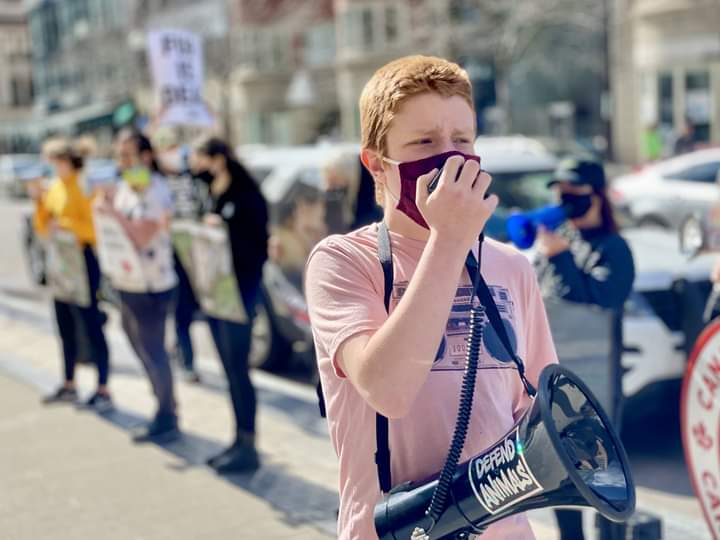
Brookline, Massachusetts (2021) – Youth Leadership
Inspired by recent wins in the towns of Wellesley and Weston, ninth-grader Ezra Kleinbaum wrote legislation to ban fur in Brookline and attended after-school hearings, winning over two-thirds of Town Meeting Members. His success demonstrated how passion and dedication could overcome age or a lack of political experience.
In an interview, Ezra noted: “It really surprised me how much opposition there was to a ban on the sale of fur. Especially since there was no fur sold in Brookline, even at the time. Although, most of the opposition stemmed from just one person.”
Two years later, Ezra and other teens worked together to successfully pass two other pro-animal ordinances in Brookline: a retail pet sales ban and a ban on using animals in circuses.

Plymouth, Massachusetts (2022) – Perseverance Pays Off
College student Lauren Nesralla faced a perfect storm of opposition when she launched a campaign to ban fur in Plymouth. The American Fur Council’s lawyers threatened legal action to block the vote while the Plymouth Agricultural Commission claimed conflicts with the town’s right-to-farm law.
Several pro-hunting groups as well as M & M Plimoth Bay Outfitters all wrote letters in opposition to town meeting members. Yet despite this coordinated opposition spreading blatant misinformation, the measure passed successfully. Nesralla’s key insight for what she’d do differently next time?
“I would have avoided media interviews until after the bylaw passed to prevent the opposition from organizing early.”
Cambridge, Massachusetts (2022) – Banning Online Fur Sales
A unanimous city council vote created one of the strongest bans yet, prohibiting even online retailers from shipping fur to Cambridge addresses. The push for the ban was initiated by Liza Oliver, founder of Fur-Free Massachusetts, in collaboration with the Massachusetts Society for the Prevention of Cruelty to Animals.
Additionally, Harvard Law School’s Animal Law & Policy Clinic provided support through letters and public comments advocating for the ordinance. Cambridge City Councilor Marc McGovern, who proposed the ordinance, worked with the MSPCA, the Humane Society, and Fur Free Alliance who played a significant role in educating the community and rallying support for the ban.
Lexington, Massachusetts (2023) – Family Activism
Town Meeting Member Dinesh Patel led a successful citizen petition, winning 160-2. Dinesh’s four grandchildren all spoke in favor of the ban at the town meeting.
Etna Borough, Pennsylvania (2023) – Small Town, Big Impact
The unanimous vote by Etna Borough Council, supported by HSUS Humane Policy Volunteer Leader Tara Czekaj, set a precedent as the first town in Lennsylvania to pass a fur ban. Tara highlighted the inhumane conditions of fur farms and the presence of fur-bearing animals in local areas.
Attleboro and Arlington, Massachusetts (2024) – Recent Wins
Last year saw continued momentum with two brand new Massachusetts bans. Attleboro’s victory came through support from a broad coalition including FurFreeMA, the Humane Society, and MSPCA. Arlington followed, with an overwhelming 194-50 vote in favor, facing no public opposition. Neither city had existing fur retailers, demonstrating the movement’s strategy of building precedent through preemptive legislation.
The Future of the Political Movement to Make Fur History
The anti-fur movement’s momentum shows no signs of slowing, but we’re entering a new phase of the fight. While passing bans remains crucial, the next frontier is ensuring meaningful enforcement of existing laws while building power towards statewide bans. Each victory provides a blueprint not just for passing legislation, but for creating lasting change in the face of industry resistance and government inertia.
What makes these campaigns so powerful? They lead with what matters most: preventing animal cruelty. With 71% of Americans opposed to killing animals for fur (2020), it’s clear that new fur is falling out of fashion, allowing local fur ban initiatives strike at the heart of where the industry increasingly operates – small retailers in our own communities. As major brands drop fur thanks to pressure from activist groups like CAFT (Coalition to Abolish the Fur Trade), these local stores become ever more crucial to the industry’s survival.
The message is clear: when passionate citizens engage with local democracy, transformative change is possible. But the real test of our movement isn’t just in passing laws – it’s in building the long-term infrastructure to ensure those laws actually protect animals. The fur industry is betting on cruel fur coming back into fashion. Let’s prove them wrong.
MAKE A DONATION TO SUPPORT OUR WORK
